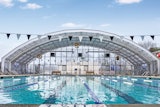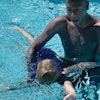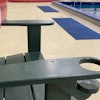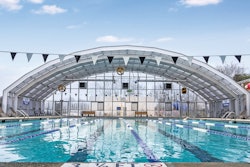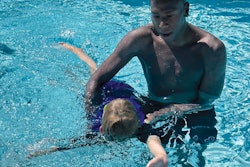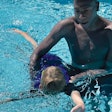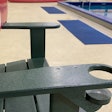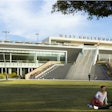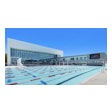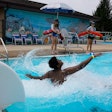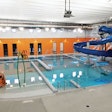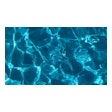When the Department of Justice enacted the ADA 2010 Standards for Accessible Design, one of the major differences from the previous version was the inclusion of regulations for swimming pools and spas.
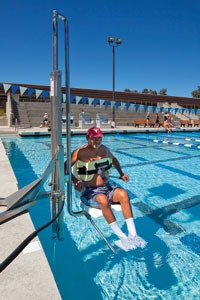 Compliance with the new ADA Standards for pools going into effect next spring can be as simple as adding a lift. (Photo courtesy of Aquatic Design Group)
Compliance with the new ADA Standards for pools going into effect next spring can be as simple as adding a lift. (Photo courtesy of Aquatic Design Group)When the Department of Justice enacted the ADA 2010 Standards for Accessible Design, one of the major differences from the previous version was the inclusion of regulations for swimming pools and spas. For many facilities, the change meant little. The 2010 Standards made mandatory a set of guidelines released by the U.S. Access Board in 2004, which many state and local governments had already incorporated into their building codes.
"The regulations, at least in California, haven't changed," says Justin Caron, an associate with Aquatic Design Group in Carlsbad, Calif. "But because they're a federal law now, it's shining a light on them in a different manner, which is forcing people to look at their situation."
Part of the confusion for facility owners is understanding which standards they are required to meet. In terms of federal regulation, the ADA 2010 Standards for Accessible Design are the first new rules to be released since the original standards released by the Department of Justice in 1991. In both cases, the standards were developed from guidelines set forth by the U.S. Access Board. Established in 1973 to research and develop guidelines for accessibility, the Access Board's scope at first only included federal facilities, which were required to be accessible by the 1968 Architectural Barriers Act. The 1990 Americans with Disabilities Act expanded the Access Board's coverage to include facilities addressed under the ADA.
After the Department of Justice adopted the Access Guidelines on the same day they were introduced in 1991, the Access Board continued to modify and develop them, issuing a new, comprehensive set of Guidelines in 2004. Unlike the original 1991 version, the 2004 Guidelines were not immediately adopted by the Department of Justice and thus did not become mandatory, though many state and local governments adopted them, and many in the architecture and design industry recognized them as best practice. "I joined the firm in 2005, and at that point, we were doing everything per the guidelines," says Caron. "As soon as the guidelines were out, we just adopted them."
The 2010 Standards make adoption mandatory. Many of the regulations apply only to new construction or renovations - under the provision of safe harbor, an element of a facility in compliance with the 1991 Standards does not need to be compliant with the 2010 Standards unless or until a renovation affecting the element is undertaken. But because no regulations for pools and spas were included in the 1991 Standards, no safe harbor exists, and all facilities must comply, to the extent that they are able, with the 2010 Standards as of March 15, 2012.
"We maybe had one or two calls within the first six months, and now we're getting one or two a week," says Caron. "It's kind of like the Virginia Graeme Baker Act, actually. As you get closer and closer to the deadline, more people become concerned."
The concern emanates most often from operators of older facilities and those located in areas that haven't already adopted the guidelines on a local level. In addition, confusion may exist over discrepancies between local and federal guidelines. A pool in compliance with local regulations may not be in compliance with federal guidelines, or different authorities may interpret elements of the 2010 Standards differently.
The Standards also apply slightly differently to facilities classified under the ADA as title II, which includes state and local government facilities, and title III, which includes private facilities that are open to the public and commercial facilities. Title III facilities must remove all barriers to access (any design feature not in compliance with the standards) wherever possible. Title II facilities must create program access without necessarily having to remove all barriers. A city-run aquatics program that utilizes multiple city pools and offers the same amenities and programming at each does not need to make all pools compliant, but needs to make a portion of its programming compliant. Whether title II or III, industry experts say all facilities should evaluate their accessibility before March 15 and create a plan to remove any barriers, which, in the case of aquatic facilities, will likely mean the addition of assistive devices.
 Though more expensive than a lift, ramps may be a better fix for aquatic facilities that cater to a larger population of people with disabilities. (Photo courtesy of Aquatic Design Group)
Though more expensive than a lift, ramps may be a better fix for aquatic facilities that cater to a larger population of people with disabilities. (Photo courtesy of Aquatic Design Group)The breakdown of the Standards for aquatic facilities is relatively straightforward. For pools with fewer than 300 linear feet of pool wall, one means of access must be provided. For pools with more than 300 linear feet, two means of access are required. For specialty pools, such as wave pools or lazy rivers, only one means of entry is necessary, and catch pools do not require any. Spas are also required to be accessible, although where multiple spas are available, only a portion of them needs to meet the requirements.
The primary means of access must be either a sloped entry (a ramp or zero-depth entry) or pool lift. The secondary means, where applicable, can be a transfer wall, a transfer system or steps. Beyond determining the number, type and location of the various means of access, a facility owner has to also consider the technical requirements spelled out for each by the Standards - the slope and landing platforms required for a ramp, measurements for the placement of handrails and seating requirements for lifts. Most manufacturers of these types of assistive devices are already quite familiar with the new specifications and their technical requirements. (The full regulations for pools and spas are spelled out in Chapter 10, Section 1009 of the Standards, with technical details for lifts, ramps and transfer devices specified in Chapter 2, Section 242.)
Reasonably priced at a few thousand dollars each and easy to install and use, lifts represent the simplest route to accessibility compliance. "You don't have to rebuild half the building," says Todd Andersen, a retired architect who served many years on the Department of Justice's ADA committee. Moreover, portable lifts can be moved or stored conveniently out of the way when not needed, minimally impacting the design of the pool.
Transfer walls, ramps or stairs may be more of a design- and cost-intensive alteration but are still viable options depending on the needs of a facility and its users. While the ADA recommends selecting different means of entry where multiple means are required, it isn't necessary. Some fixes may be as simple as adding handrails.
That said, problems can arise in unexpected places - wading pools, whose intended use requires a sloped entry, and zero-depth-entry pools. Sloped entry does not automatically equate to accessibility; the grade of the slope, depth of the pool and location of landings must also be considered. In some cases, meeting these requirements would be nearly impossible without completely redesigning the pool. Therefore, some leeway exists.
"Owners of title III pools are required to remove barriers where readily achievable, which is defined as easily accomplishable and able to be carried out without much difficulty or expense," says the Access Board's Jim Pecht. "So it's basically got to be easy and cheap and you have to have the financial wherewithal at that point in time to do it. If it's too expensive or too difficult, you're not required to do it. You might be required to do it somewhere down the road when it becomes readily achievable."
Compliance exemptions could be harder to come by for the basic lap pool, since alterations can be made with relatively little cost or difficulty. Potential problems arise when facilities have a more complex design, featuring multiple pools or a combination of design features. "It becomes a more difficult situation in contemporary pools that have current channels and infinity edges, things that may complicate accessibility," says Stephen Springs, a principal with Brinkley Sargent Architects of Dallas. "The larger and more complicated your perimeter, the more challenging it may be to provide accessible locations in your design."
The 2010 Standards also include regulations for playground equipment that were absent from the 1991 Standards. Many of those new regulations apply to spray parks and aquatic play areas (though waterslides are specifically excluded). With so much design variation possible, it can be hard to determine to what extent all elements need to be accessible.
"Some of the aquatic centers that have complicated play elements in the water itself are going to have issues," says Andersen. "The regulations don't necessarily give you designs for complicated things, they give you designs for all the bits and pieces." Because there are no previous federal examples to provide guidance for the comingling of play equipment and aquatic standards, Caron says the team at Aquatic Design Group is playing it safe, designing in accessibility wherever possible. Many elements of aquatic play equipment can be modified to turn steps into transfer tiers with the addition of grab bars. As with manufacturers of assistive devices, makers of aquatic play equipment will be expected to take the Standards into consideration when designing future products.
Most construction or renovation projects undertaken since the 2010 Standards were released have followed the new regulations. Depending on local regulations, accessibility compliance may be considered when issuing building permits or licenses. Many local and state agencies also have services in place to monitor new construction and offer guidance. "In Texas, there's an enforcement arm to ensure compliance with accessibility guidelines," says Springs, whose firm employs an accessibility consultant on all of its projects. "It's routine around here to have an accessibility consultant on the team looking over your shoulder. As these new regulations come into play, those consultants will have more scope to review."
For owners of existing facilities who have not made any changes in recent years and are unsure what, if any, changes they need to make - and which are even possible - Springs recommends an audit. "The fear in doing an audit is that it uncovers problems and then you have to spend money to solve them," he says. "But having the audit actually gives you some defense because you can say, 'We've done this audit and this is our plan of action.'"
An audit or plan of action shows that a facility is aware of any noncompliance issues and either has met them to the extent that is readily achievable or is taking steps to correct them over the course of time - exactly what the Department of Justice wants to see, according to Pecht. Using the 2010 Standards as a benchmark, he recommends looking at elements of the facility. Anything that falls short of the requirements is a barrier to access and should be noted. "Then you look at that list, and you examine those barriers. Ask, 'Is it physically possible to remove this barrier?' Sometimes the answer is no, it's not possible. So that goes off the list; you're not required to deal with that.
"If it's physically doable, the next question is how much it is going to cost to remove that barrier. Sometimes things are so expensive, they're never going to be readily achievable. They go off the list. What you're left with is a list of things that independently are easy and you can afford to deal with."
Not every repair on the list needs to be made at once, either. The Department of Justice recommends prioritizing the list, with access to the building being at the top, followed by access to primary services. All the repairs may not be financially feasible at one time, but a few a year might be, or some may become feasible as the budget of the facility fluctuates. Ultimately, the Department of Justice is responsible for the enforcement of the regulations, but the issues will begin at the local level.
"Throughout the country there are independent living centers, facilities where people with disabilities live in a group setting - living as independent a life as they can," says Andersen. "They tend to be quite interested in their local facilities. I'll bet you a lot of public pools have already had contact with some of these kinds of groups."
Often, it's these groups, or other individuals who were unable to access a facility's services because of barriers, who provide the impetus for action. Complaints (or, worse, lawsuits) may be brought directly to the attention of the business or filed with the Department of Justice. The Department of Justice offers mediation services to resolve issues and also has the authority to intervene in cases related to ADA issues and file lawsuits to enforce the ADA. Most often, the settlement of these cases requires a business to make changes to comply with the regulations, though monetary damages may be awarded to affected parties, and title III facilities can be fined as much as $55,000 for the first offense and $110,000 for subsequent offenses.
Bringing a pool or aquatic facility up to date with the 2010 Standards can be a relatively inexpensive and easy fix, but facility operators would do well to look past the quickest and cheapest solutions. Though very few facilities/facility owners have the means to use the new regulations as an excuse for a more extensive renovation or update - Caron says about 80 percent of those he's talked with are concerned only with meeting the regulations - the regulations do present an opportunity to garner a greater percentage of the country's largest minority group. There are more than 50 million people with disabilities in the United States. Whether they are among a particular facility's demographic, they may represent the friends and family of a facility's users, or future users, as more than 70 million baby boomers grow older.
"It's not necessarily the number of people with disabilities, it's the size of their families," says Andersen. "The programs can also change over time. Maybe your Y was mostly dealing with middle-aged people doing laps, and now you've got a lot of seniors doing some sort of aquatic exercise."
Rather than thinking of the new standards as another building requirement, pool owners should treat them as they would any other element designed to increase users' enjoyment of the facility. The addition of stairs or a ramp, or a submersible wheelchair (another inexpensive recommendation in the 2010 Standards), might be the difference between users selecting one facility over another.
"Not to generalize, but it's our opinion that people with physical impediments go through things every day that able-bodied people don't," Caron says, "and it shouldn't be that hard to design something they can use."
Permitted Means of Pool Access
| Pool Type | Sloped Entry | Lift | Transfer Walls | Transfer Systems | Stairs |
| Swimming pools with less than 300 linear feet of pool wall | X | X | |||
| Swimming pools with 300 or more linear feet of pool wall - two means of entry required | X* | X* | X | X | X |
| Wave action, leisure river, other pools where user entry is limited to one area | X | X | X | ||
| Wading pools | X | ||||
| Spas | X | X | X |
*Where two means of access are required, the first must be either a sloped entry or pool lift. Catch pools do not require any accessible means of entry.










